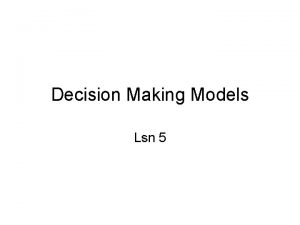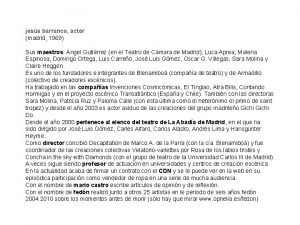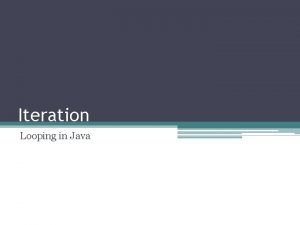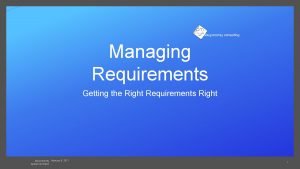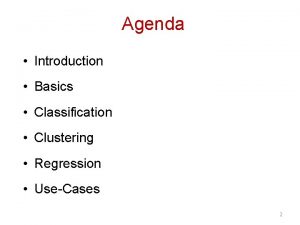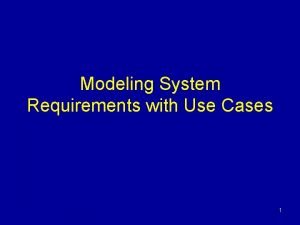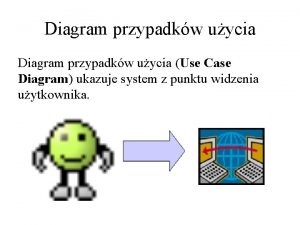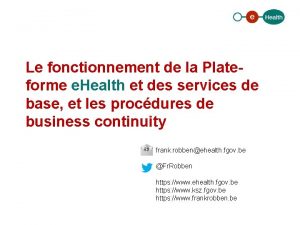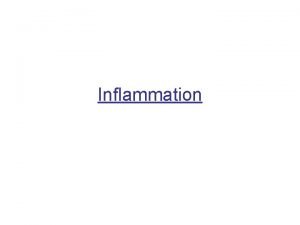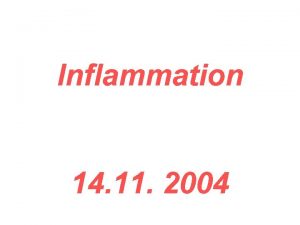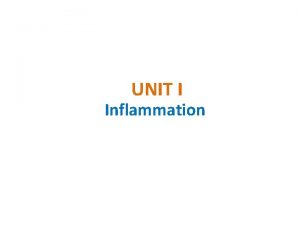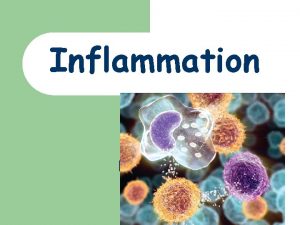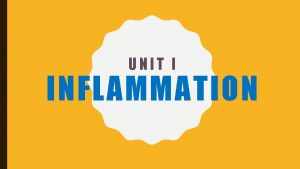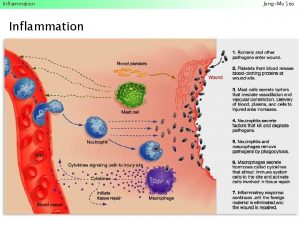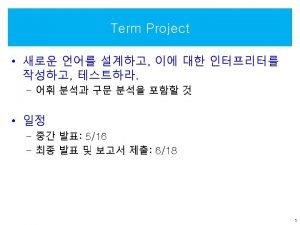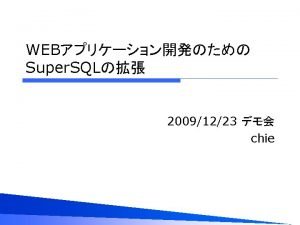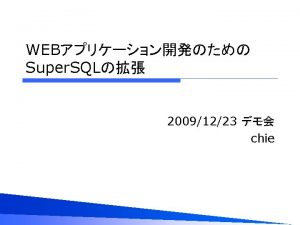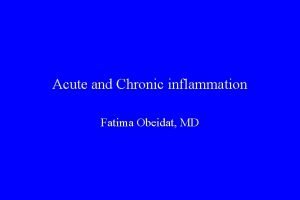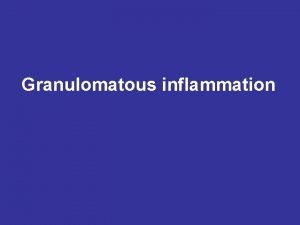GI System Actor 1 AppendicitisUnderlying causepathophysiology Inflammation of










































































- Slides: 74

GI System

Actor #1

Appendicitis-Underlying cause/pathophysiology • Inflammation of the appendix • The appendix has no known function in the body, but it can become diseased and inflamed and considered and emergency. • If left untreated, the appendix may rupture and cause a potentially fatal infection of the abdominal lining known as peritonitis • Most common in people between the ages of 10 and 30, but it can develop at any age. In a few cases, appendicitis has been diagnosed in newborn babies.

Appendicitis- Underlying cause/pathophysiology • Develops when the lumen (inner cavity) of the appendix is blocked ranging from intestinal parasites to fecal matter to tumors to infection. • As blockage progresses tissues of the appendix begin to die from lack of blood flow. They are then invaded by bacteria and form pus. If the condition is not treated, the appendix swells and eventually bursts, spreading the infection throughout the abdomen=peritonitis • What nursing priorities will guide your plan of care? • What labs and assessments are relevant to this patient? What might we see with VS?

Appendicitis • Pain usually starts two to three days before the appendix gets to the point of bursting, where is Mc. Burney’s point? • Classic symptoms of appendicitis are nausea, vomiting, low-grade fever, and loss of appetite, rebound tenderness (fewer than 50 %) • Children and the elderly are often misdiagnosed because they have fewer of these symptoms; in particular, very young children may be misdiagnosed because they cannot explain or describe their symptoms. As a result, their treatment is often delayed. • Signs of rupture include the presence of symptoms for more than 24 hours, fever, high white blood cell count, tachycardia. • Sudden relief from pain could indicate that appendix has ruptured. • Nursing interventions and why are you performing these?

Appendicitis • Emergency care is as follows • Establish IV access and administer aggressive crystalloid therapy to patients with clinical signs of dehydration or septicemia • Keep patients with suspected appendicitis NPO • Administer parenteral analgesic and antiemetic as needed for patient comfort • Antibiotics • Antibiotic prophylaxis usually administered before every appendectomy • Antibiotic treatment may be stopped when the patient becomes afebrile and the WBC count normalizes

Appendicitis

Q • The nurse is monitoring a client admitted to the hospital with a diagnosis of appendicitis who is scheduled for surgery in 2 hours. The client begins to complain of increased abdominal pain and begins to vomit. On assessment, the nurse notes that the abdomen is distended and bowel sounds are diminished. Which is the most appropriate nursing intervention? A. Notify the health care provider (HCP). B. Administer the prescribed pain medication. C. Call and ask the operating room team to perform the surgery as soon as possible. D. Reposition the client and apply a heating pad on the warm setting to the client's abdomen.

A • Notify the health care provider (HCP). • On the basis of the signs and symptoms presented in the question, the nurse should suspect peritonitis and notify the HCP. Administering pain medication is not an appropriate intervention. Heat should never be applied to the abdomen of a client with suspected appendicitis because of the risk of rupture. Scheduling surgical time is not within the scope of nursing practice, although the HCP probably would perform the surgery earlier than the prescheduled time.

Q • The nurse is caring for a client admitted to the hospital with a suspected diagnosis of acute appendicitis. Which laboratory result should the nurse expect to note if the client does have appendicitis? A. Leukopenia with a shift to the left B. Leukocytosis with a shift to the left C. Leukopenia with a shift to the right D. Leukocytosis with a shift to the right

A • B. Leukocytosis with a shift to the left • Laboratory findings do not establish the diagnosis of appendicitis, but there is often an elevation of the white blood cell count (leukocytosis) with a shift to the left (an increased number of immature white blood cells).

Q • A client arrives at the hospital emergency department complaining of acute right lower quadrant abdominal pain, and appendicitis is suspected. Laboratory tests are performed, and the nurse notes that the client's white blood cell (WBC) count is elevated. On the basis of these findings, the nurse would question which health care provider's (HCP) prescriptions documented in the client's medical record? A. Apply a cold pack to the abdomen. B. Administer 30 m. L of milk of magnesia (MOM). C. Maintain nothing-by-mouth [NPO] status. D. Initiate an intravenous (IV) line for the administration of IV fluids.

A • B. Administer 30 m. L of milk of magnesia (MOM). • Appendicitis should be suspected in a client with an elevated WBC count complaining of acute right lower abdominal quadrant pain. Laxatives are never prescribed because if appendicitis is present, the effect of the laxative may cause a rupture with resultant peritonitis. Cold packs may be prescribed for comfort. The client would be NPO and given IV fluids in preparation for possible surgery.

Actor #2

Abdominal Trauma-underlying cause/pathophysiology • Blunt or penetrating- ½ blunt from MVAs and most penetrating from GSWs • What are some relevant assessment findings? Labs? What VS may you see? Why are we worried about patient going into shock? What are your priority interventions?

Priorities • • • Airway, oxygen Control bleeding IVF large bore catheters Blood type cross and match Ongoing- LOC, Oxygen sats, and UOP

Abdominal Trauma • Ecchymotic areas could indicate major organ injury so assess for abdominal guarding or rigidity and notify MD. Very important to monitor VS! • Considerations- Objects impaling a patient should not be removed and emergency management for shock is always indicated. • Check VS and get IV started ASAP. • Since bleed not always obvious what are you monitoring for?

Abdominal Trauma

Actor #3

IBS- pathophysiology • Intestinal condition characterized by abdominal pain and cramps, changes in bowel movements (diarrhea, constipation, or both), gassiness, bloating, nausea, and other symptoms. • There is no cure for IBS. Much about the condition remains unknown or poorly understood; however, dietary changes, drugs, and psychological treatment are often able to eliminate or substantially reduce its symptoms • Symptoms of IBS tend to rise and fall in intensity rather than growing steadily worse over time. • Other symptoms include cramps, gassiness, bloating, nausea, a powerful and uncontrollable urge to defecate (urgency), passage of mucus during bowel movements, or the feeling after finishing a bowel movement that the bowels are not completely empty. • As a nurse what will you focus your teaching on?

IBS • Researchers remain unsure about the cause or causes of IBS but diet and stress appear to play a role among other theories • Low-fat, high-fiber (30 -40 grams/day) diet recommended with 8 -10 glasses water/day • Problem-causing substances such as lactose, caffeine, beans, cabbage, broccoli, fatty foods, alcohol, and medications should be identified and avoided. • Bran or 15 -25 g a day of an over-the-counter psyllium laxative (Metamucil or Fiberall) may also help both constipation and diarrhea. Antidiarrheal agents. Can still have milk or milk products if lactose intolerance is not a problem. People with irregular bowel habits, particularly constipated patients, may be helped by establishing set times for meals and bathroom visits. • Complementary and Alternative Therapies: acupuncture, herbs, peppermint oil, meditation, yoga

IBS

Actor #4 and #5

Inflammatory Bowel Disease • Crohn’s disease • Ulcerative colitis • Autoimmune disorders characterized by chronic inflammation of intestine with periods of remission and exacerbations. • Unknown cause, no cure • Relies on meds to treat acute inflammation and maintain remission • Surgery for patients who unresponsive to meds or who develop complications. • Toxic megacolon- rare, life-threatening complication of severe colon disease or infection. Diagnosed when your colon has expanded by more than five to six centimeters. Risk for systemic infection, shock, and dehydration.

Inflammatory Bowel Disease • Ulcerative colitis-Inflammation can extend to entire colon but usually rectum and sigmoid. • In severe cases bleeding and ulcerations occur. Abscesses can lead to necrosis. • Stool=blood and mucous. Malaise, anorexia, anemia, dehydration, fever and weight loss. • Colonoscopy- best to diagnose. • ESR rates (norm 0 to 33) which indicates inflammation elevate during exacerbation, also increase WBC and C-reactive protein (shows inflammation).

Inflammatory Bowel Disease • Crohn's disease causes inflammation anywhere along the lining of your digestive tract, and often spreads deep into affected tissues causing strictures and deep ulcerations. This can lead to crampy abdominal pain, severe diarrhea and malnutrition (since cannot absorb nutrients). • If inflammation goes through bowel wall can leak contents into peritoneal cavity. • Many complications including fistulas, intestinal obstructions, malabsorption • What medications are relevant?

Inflammatory Bowel Disease • Drug therapy includes • Anti-inflammatory • Immune suppressors-These drugs also reduce inflammation, but they target your immune system rather than treating inflammation itself. Because immune suppressors can be effective in treating ulcerative colitis, scientists theorize that damage to digestive tissues is caused by your body's immune response to an invading virus or bacterium or even to your own tissue. By suppressing this response, inflammation is also reduced. • Antibiotics can reduce the amount of drainage and sometimes heal fistulas and abscesses in people with Crohn's disease • Antidiarrheal, pain medication, vit B 12, Calcium and Vit D • Biologic (living organisms) and targeted therapy (block growth) • What nursing interventions will you initiate?

IBD Interventions • • • Rest bowel so NPO status -monitor I/O Monitor for occult blood in stools, labs Pain control Decrease stress Quit smoking Skin care Dietary considerations- correct any malnutrition Control inflammation Combat infection Improve quality of life- psychosocial issues Hemodynamic stability- potential for GI bleed, consider FVD from severe diarrhea

IBD Interventions • Fluid and electrolyte imbalances- huge risk of cardiac dysrhythmias secondary to K and Mg loss from severe diarrhea • Colonoscopy- long term inflammatory bowel disease increases risk of colon cancer, so regular colonoscopies every few years. • Surgical management in severe or uncontrolled cases and sometimes to let the bowel rest.

IBD

Q • The nurse is reviewing the record of a client with Crohn's disease. Which stool characteristic should the nurse expect to note documented in the client's record? A. Diarrhea B. Chronic Constipation C. Constipation alternating with diarrhea D. Stool constantly oozing from the rectum

A • A. Diarrhea • Crohn's disease is characterized by nonbloody diarrhea of usually not more than four to five stools daily. Over time, the diarrhea episodes increase in frequency, duration, and severity. Options 2, 3, and 4 are not characteristics of Crohn's disease.

Q • In performing a physical assessment of a client with a diagnosis of ulcerative colitis exacerbation, the nurse should expect which finding? A. Hypercalcemia B. Fibrous stricture C. Frothy, fatty stools D. Decreased hemoglobin

A • D. Decreased hemoglobin • Ulcerative colitis is an inflammatory disease of the large colon. The signs and symptoms of ulcerative colitis include diarrhea with up to 10 to 20 liquid bloody stools per day, weight loss, anorexia, fatigue, increased white blood cell count, increased erythrocyte sedimentation rate, dehydration, hyponatremia, and hypokalemia, not hypercalcemia. Because of the loss of blood, clients with ulcerative colitis commonly have decreased hemoglobin and hematocrit levels. Strictures and fistulas are more commonly seen in Crohn's disease than in ulcerative colitis. Clients with ulcerative colitis have bloody diarrhea, not steatorrhea (fatty, frothy, foul-smelling stools).

Q • The nurse is assisting a client with Crohn's disease to ambulate to the bathroom. After the client has a bowel movement, the nurse should assess the stool for which characteristic that is expected with this disease? A. Blood in the stool B. Chalky gray stool C. Loose watery stool D. Dry, hard, constipated stool

A • C. loose watery stool • Crohn's disease is characterized by nonbloody diarrhea of usually not more than four or five stools daily. Over time, the episodes of diarrhea increase in frequency, duration, and severity. Options 1, 2, and 4 are not characteristics of the stool in Crohn's disease.

Story Time • http: //www. youtube. com/watch? v=7 a 2 Cz. DZ_te 4&feature=re lated

Actor #6

Intestinal obstruction • Mechanical- Detectable occlusions such as with adhesions, tumors, strictures • Nonmechanical- neuromuscular or vascular disorder such as with paralytic ileus. • Partial or complete • Signs and symptoms- abdominal pain and distention, nausea, and vomiting. If left untreated, intestinal obstruction cause the blocked parts of your intestine to die. This tissue death can lead to perforation of the intestine, severe infection and shock. • What are our priority assessments? What nursing priorities will guide your plan of care?

Intestinal obstruction • Small bowel obstructions can lead to severe fluid and electrolyte imbalances. • Assess for abdominal distention, especially on high risk patients, as this could indicate an obstruction. • Change in the nature of pain in obstruction could signal peritonitis or perforation so nurse should immediately check for rebound tenderness and bowel sounds.

Obstruction • All patients with suspected intestinal obstruction are hospitalized. Treatment must be rapid, because strangulating obstructions can be fatal. Treatment may consist of inserting NG tube to suction out the contents of the stomach and intestines. The patient is then given intravenous fluids to prevent dehydration and correct electrolyte imbalances. • Nursing considerations: I/O, abdominal girth measurements, Fluid and electrolytes, emesis (frequency, odor), pain management

Obstruction • If other efforts fail, surgery is necessary. Strangulated obstructions require emergency surgery. The obstructed area is removed and part of the bowel is cut away. If the obstruction is caused by tumors, polyps, or scar tissue, they are removed. Antibiotics are given to reduce the possibility of infection. • Labs • • • Increase WBC could indicate perforation or strangulation Increase in Hct could indicate hemoconcentration Decrease in H/H could indicate bleeding Electrolytes, BUN, Cr help assess dehydration Metabolic alkalosis from vomiting • Diagnostics: CT, abd x-ray

Obstruction

Actor #7

Peritonitis • Inflammatory process of peritoneum- get infection treated • Peritoneum normally a sterile area • Primary- infection via bloodstream, more rare than secondary • Ex- ascites from cirrhosis of liver provides great environment for bacterial to flourish • Secondary- abd organs perforate or rupture (ruptured appy) and spill contents into peritoneum. • Abdominal pain most common symptom, what are some other clinical manifestations? • What other complications can peritonitis lead to? • What nursing interventions will you initiate?

Peritonitis • Clinical manifestations • Rigid board like abd, distention, NV, no flatus/stool, diminishing bowel sounds, rebound tenderness, fever, tachy, can cause respiratory complications • Interventions • IV fluids, abx, weight, I & O, NG, NPO, possibly oxygen, pain control • Surgery- identify and repair cause of peritonitis, control contamination, remove any foreign material, drain fluid • After surgery what are you monitoring for?

Peritonitis

Actor #8

Colorectal Cancer 3 rd most common form of cancer Insidious onset- symptoms not appearing until advanced Risk factors include age, history, polyps, IBD, lifestyle Rectal bleeding, anemia, and change is stool consistency or shape most common manifestation • Advocate regular screenings- Healthy People 2020 goal promoting evidence-based screening for cervical, colorectal, and breast cancer. Objectives also highlight the importance of monitoring the incidence of invasive cancer (cervical and colorectal) and late-stage breast cancer, which are intermediate markers of cancer screening success. • Screenings 50 years and average risk • Surgical therapy, worry is about metastasizing • •

Colorectal Cancer

Actor #9

Diverticulitis Diverticula-pouchlike herniations in wall of intestine Diverticulosis-MANY pouchlike herniations Diverticulitis-inflammation of the diverticula CT scans allows for visualization of inflamed/infected pouches and rule out other conditions that mimic diverticulitis, such as irritable bowel syndrome. XR, Upper GI, Barium enema (not in acute phase) • What labs, VS, and assessments will you address? • What nursing priorities will guide your plan of care? • What nursing interventions will you initiate? • •

Diverticulitis Check WBC, H/H, occult blood NPO for severe symptoms Dietary as appropriate- high fiber after acute phase Medications antibiotics and pain meds as needed No laxatives during acute phase as this increase pressure in bowel, causing more outpouching of the lumen. • Severe cases or recurrent attacks of diverticulitis or at risk of complications from the condition, may need surgery to remove the diseased portion of colon. • Acute pain to LLQ- main symptom • Table 43 -30 p 995 nice outline of care • • •

Diverticulitis

Q • A client is admitted to the hospital with a diagnosis of acute diverticulitis. What should the nurse expect to be prescribed for this client? A. NPO (nothing by mouth) status B. Ambulation at least four times daily C. Cholinergic medications to reduce pain D. Coughing and deep breathing every 2 hours

A • A NPO (nothing by mouth) status • During the acute phase of diverticulitis, the goal of treatment is to rest the bowel and allow the inflammation to subside. The client remains NPO and is placed on bed rest. Pain occurs from bowel spasms, and increased intra-abdominal pressure (coughing and deep breathing) may precipitate an attack. Ambulation and cholinergic will increase peristalsis. The remaining options are not interventions for the client with acute diverticulitis.

Actor #10

Food Poisoning • Salmonella=dehydration r/t diarrhea so fluid balance is a priority!! Transmitted by “five Fs” • Take all medications as ordered, carriers up to a year. • Botulism- paralytic disease, home canned foods. Risk for respiratory failure so watch! • Tx is botulism antitoxin, no honey in infants <12 months as spores have been found in honey. These bacteria are typically harmless to older kids and adults because their mature digestive systems can move the spores through the body before they cause any harm, but not infants quite ye. • Staphylococcus aureus- meat and dairy, unrefrigerated over period of time. Sudden onset of vomiting, abd cramping, and diarrhea within 2 -4 hours. • Usually just fluids • E. coli- severe cramping, vomiting, may have bloody diarrhea • IV fluids, abx not effective • Wash hands, use different cutting boards for meat and veggies

Food Poisoning

Actor #11

Gastroenteritis • Intestinal infection marked by watery diarrhea, abdominal cramps, nausea or vomiting, and sometimes fever. • Often called stomach flu — is through contact with an infected person or ingestion of contaminated food or water. If otherwise healthy, usually recover without complications. But for infants, older adults and people with compromised immune systems it can be deadly. • What changes in labs and VS will you trend? • What assessments will be relevant? • What nursing priorities will guide your plan of care? • What nursing interventions will you initiate?

Gastroenteritis • Diet- encourage fluids to prevent dehydration, may need IV hydration depending upon severity, orthostatic VS • Drugs that suppress motility should not be given, abx if bacterial • Good skin care

Gastroenteritis

Commercial Break • http: //www. youtube. com/watch? v=6 M_b. BOSV 67 Y&feature= related • http: //www. youtube. com/watch? v=HOa. ZCk. A 8 Zvk&feature=r elated

Actor #12

Lower GI Bleed • Upper- can be from PUD, CA, esophageal varices • Bright red- arterial source and profuse, has not come into contact with gastric acid • Coffee ground-blood in stomach for awhile • Melena- black, tarry stools, slow upper GI bleed, longer passage of blood through intestines the darker the stool related to breakdown of Hbg and release of iron • Lower- depending on location of bleed can be bright red, melena (black tarry), or maroon. Can be slow trickle to massive hemorrhage. If an upper bleed is massive and brisk could present with bright red blood per rectum. Colonoscopy. • Caused by variety of issues such as inflammatory condition, cancer, diverticulosis, infection (salmonella)

Nursing Management • What labs will you monitor for? What nursing assessments will be your priority and why? What interventions will initiate ?

Lower GI Bleed • Monitor CBC, coag studies, and electrolytes. Monitor hemodynamic status, cardiovascular assessment, neurological assessment • Initially IV fluid resuscitation with large bore IV access and what fluid? The blood loss and hemodynamic status determined. • Various tx depending on problem/cause including surgery, epi injection at site (via colonoscopy). Worst case vasoconstrictive agents if unknown where bleed is and unstable.

GI bleed

Q • A client presents to the emergency department with upper gastrointestinal bleeding and is in moderate distress. In planning care, what is the priority nursing action for this client? A. Assessment of vital signs B. Completion of abdominal examination C. Insertion of the prescribed nasogastric tube D. Thorough investigation of precipitating events

A • A. VS • The priority nursing action is to assess the vital signs. This would indicate the amount of blood loss that has occurred and provide a baseline by which to monitor the progress of treatment. The client may be unable to provide subjective data until the immediate physical needs are met. Although an abdominal examination and an assessment of the precipitating events may be necessary, these actions are not the priority. Insertion of a nasogastric tube is not the priority; in addition, the vital signs should be checked before performing this procedure.

Overall GI assessment • This includes what? What labs are important? What are patient priorities? How can the GI system affect other systems?

Are You Stressed? • Study done at GBC. The picture shows 2 dolphins. • Those who were experiencing stress saw a difference between the two dolphins. • Those who were NOT experiencing stress saw no difference between the two dolphins. • Use this as a guide during each semester to determine if YOU are stressed.

 Dramaturgo poeta y actor inglés
Dramaturgo poeta y actor inglés Zhen jiang actor
Zhen jiang actor John pryor actor
John pryor actor Richard pattinson
Richard pattinson Ray tracing actor
Ray tracing actor Herramientas del actor
Herramientas del actor Robert cormier actor
Robert cormier actor Juan figueres es ____.
Juan figueres es ____. Actors in foreign policy
Actors in foreign policy Diagram actor
Diagram actor Method actor meaning
Method actor meaning Strengths and weaknesses in drama
Strengths and weaknesses in drama Guess that celebrity
Guess that celebrity Simon osborne actor
Simon osborne actor Boundary class in uml
Boundary class in uml Jesus barranco actor
Jesus barranco actor In greenfoot, you can cast an actor class to a world class?
In greenfoot, you can cast an actor class to a world class? Doug murray actor
Doug murray actor Actor oriented programming
Actor oriented programming Andy rooney actor
Andy rooney actor Shakespeare aka the bard of
Shakespeare aka the bard of Actor dinotasikan dengan gambar
Actor dinotasikan dengan gambar Character analysis worksheet for actors
Character analysis worksheet for actors Carlos posada actor
Carlos posada actor James hurst actor
James hurst actor Kelly brown actor
Kelly brown actor An actor is always outside of the automation boundary
An actor is always outside of the automation boundary Halimbawa ng affixes
Halimbawa ng affixes Unitary actor realism
Unitary actor realism Greek theatre stage
Greek theatre stage Luis cerda actor
Luis cerda actor Actor director musician
Actor director musician Superlative of tiny
Superlative of tiny Affix of actor
Affix of actor Famous latino male actors
Famous latino male actors Actor de cine mudo
Actor de cine mudo Tropic thunder budget and gross
Tropic thunder budget and gross Classification regression clustering
Classification regression clustering Language
Language Amst actor language
Amst actor language Actor massage
Actor massage Actor frameworks
Actor frameworks Permissieve samenleving
Permissieve samenleving Actor model microservices
Actor model microservices Joseph elliott actor
Joseph elliott actor James cagney biography
James cagney biography English comic actor and film director
English comic actor and film director English comic actor and film director
English comic actor and film director Name of actor
Name of actor English comic actor and film director
English comic actor and film director Illusion of asymmetric insight
Illusion of asymmetric insight Actor model concurrency
Actor model concurrency Actor critic network
Actor critic network Actor model languages
Actor model languages Polaris actor
Polaris actor Actor chart
Actor chart Actor focus vs object focus
Actor focus vs object focus Actor visio
Actor visio My uncle is an actor
My uncle is an actor Martin kruger actor
Martin kruger actor Organization/actor catalog
Organization/actor catalog Actor observer
Actor observer Jaime andres castaño actor
Jaime andres castaño actor Ethan is observing chemical and physical properties
Ethan is observing chemical and physical properties Craig marshall actor
Craig marshall actor Member2club
Member2club Tools of an actor or actress
Tools of an actor or actress Extend use case
Extend use case William shakespeare english poets
William shakespeare english poets John pryor actor
John pryor actor Rational actor model
Rational actor model Sentido mentado
Sentido mentado Migdad actor
Migdad actor Mega actor
Mega actor Common base registry for healthcare actor
Common base registry for healthcare actor








